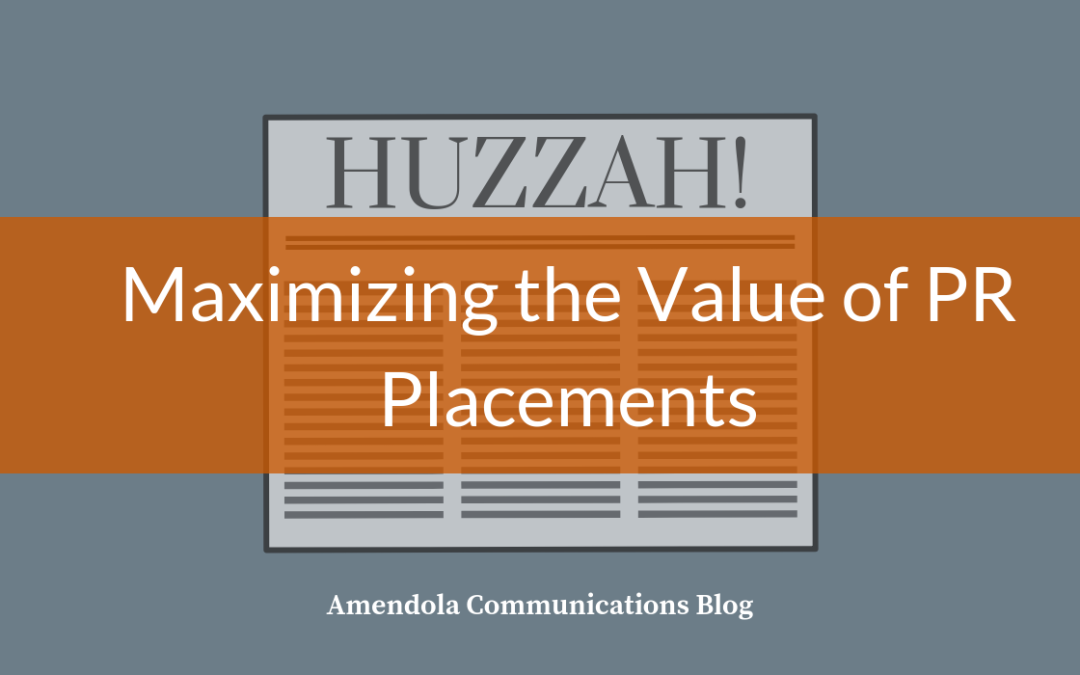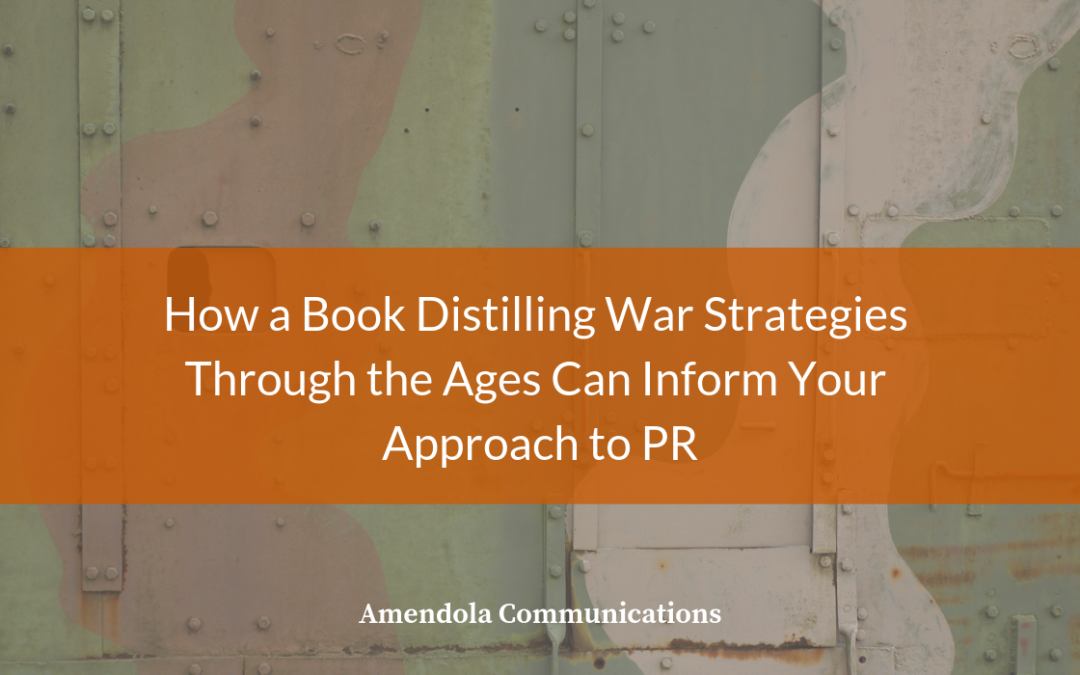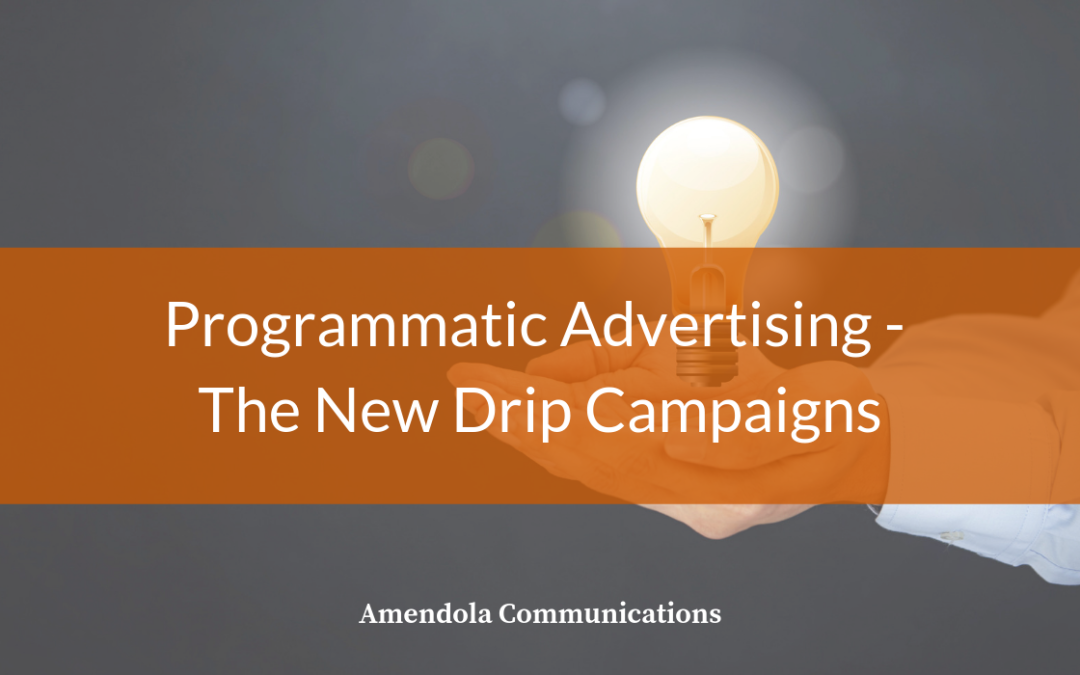
by Ken Krause | Apr 3, 2019 | Blog
The big day has finally arrived. After rearranging schedules, sweating out interviews or writing deadlines, and walking the line between “persistent” and “pest” your PR placement has seen the light of day.
Huzzah! (I am bound and determined to bring back “huzzah” as something people say when something great occurs.)
It feels like a weight has been lifted off of everyone’s shoulders especially in the case of an interview, where you had little to no control over the content. Fortunately your SME sounded like the expert he/she is rather than a babbling idiot who struggles to string two coherent sentences together.
It’s easy to think that you’ve now reached an end point, closed the loop as it were, so you can move on to the next crisis opportunity du jour. If you do that, however, the benefits of all that work end up having about the same lifespan as a mayfly here today, gone tomorrow and all that. (If you click the link it will count as your “I learned something today” moment.)
The reality is the article appearing online or in print isn’t the end point. Instead, it’s really just the starting point.
Here are a few ways you can take better advantage of all that nerve-wracking work and maximize the value of those hard-earned PR placements.
Share via social media channels
This tactic should be a no-brainer, but it’s amazing how often organizations don’t take advantage of this opportunity.
When a PR placement appears an interview, a byline article, a case study, even a good quality rewrite of your press release you should let the world know. Send a Tweet with a link. Put together a one- or two-sentence summary and post it on LinkedIn, Facebook, and/or whatever other channels you use and send it out.
Don’t trust that the people you want to influence will come across this great example of your expertise by happenstance. Be proactive in telling them it’s there.
By the way, taking this approach has an added benefit. The media (even trade media) is very focused on getting traffic to their sites. If you help them with it by sharing they will notice. And they just may be a little more inclined to read your email or take your call the next time you have a story for them.
Email your customers and prospects
Don’t assume that your target audiences will see the original article, or are following you on your social channels. Having your sales team email the article directly to them is a great way to make them aware of your great PR placement.
It also gives you an opportunity to focus it more specifically on your company since most PR placements will tend to be vendor-neutral. If your salespeople aren’t good at writing emails, have your marketing team or PR agency craft the message with some blanks that can be filled in to personalize it.
That doesn’t mean you can send them the entire article unless you’ve paid for a reprint of course. But fair use laws usually allow you to share a paragraph or so. Pick one that you can use as a launching pad, and again direct the email recipient to the publication’s website.
One word of caution with emails, however. Make sure the PR placement you’re promoting has some level of value to the reader. You don’t need to send out every personnel announcement or minor upgrade release that appears. That’s a quick way to ensure ALL your emails get deleted.
But if you share good information that demonstrates your organization’s knowledge and expertise you can condition your audience that it’s worth their time to see what you’re sending.
Post them in your online newsroom
Again, nothing revolutionary here but you’d be surprised how many organizations miss this opportunity because they feel they don’t have time, or have more important things to do. My advice to you is make the time.
Think about it from a prospect’s standpoint. The decision-maker has never done business with you before, but thinks he/she might want to. So what does he/she do? For many, the first step is to check out your website.
That checking out process includes looking at news about your company. If there isn’t much news there it’s easy for the prospect to assume there’s not much happening at the company on a regular basis. Even without that assumption, however, he won’t learn very much from an empty newsroom.
But if you have press releases, published articles, case studies, etc. readily available the impression that prospect will get is that your company is a very active, happenin’ place. He/she will also see that your experts are well-respected because their thought leadership is appearing in a variety of industry publications. Never underestimate the power of the implied third-party endorsement.
Again, unless you’ve paid for online reprint rights you can’t post the article in its entirety. But you can offer an excerpt, or a summary, with a link to the original article.
That’s actually better for you, because then the publication’s masthead is tied to the article, ensuring its legitimacy. Just remember to set the publication’s website to pop up in a new window so when the visitor is done reading the article he/she still has your website open.
The online newsroom is also good for customers. Everyone wants to associate themselves with winners. An active online newsroom is confirmation that they’ve made a good choice.
Include them in sales presentations
Just about every sales presentation, at least in the initial stages, has a section that talks about who the company is and what it stands for. That’s an ideal place to insert a slide with an array of PR placements to show that your organization understands the industry and its challenges and has recognized solutions.
Try to include multiple topics from different people to demonstrate a breadth of expertise. If they are all from one expert, however, that’s ok too. You can promote that person as a recognized authority; if the prospect wants the benefit of that person’s knowledge there is only one place to get it.
Display them in your trade show booth
To ensure your PR placements are the gifts that keep on giving, try creating a graphic panel showing some of your best articles, case studies, etc. in larger-than-life format. Think of a movie poster.
If you can’t do that do to space or cost considerations, think about creating easel cards that can sit on counters or shelves.
Even if no one stops to read them and the odds are they won’t it’s a quick way to capture some attention and tell show attendees that your organization is a player in the industry.
Post them around the office
Another great way to gain lasting value is to frame significant PR placements and post them in various locations around the office, including the lobby, hallway, and conference rooms. You can even double down on a few if you don’t place them too close together as it’s unlikely anyone will stop to read them all.
If the article is in a print magazine (yes, there still are some left), have someone with an artistic flair cut it out with an Exacto knife. If it’s online, buy some high-quality glossy paper and print it out. Then take it to a professional framing shop and have them do the final work.
These framed reprints aren’t just for the benefit of customers and prospects either. They can also help get potential employees excited about coming to work for such a well-known, well-respected organization, and keep current employees feeling good about it.
If you have a video display in the front lobby, cafeteria, or other areas, be sure your best PR placements show up there as well. Anything you can do to make them visible within the office is a plus.
Get your money’s worth
These are just a few of the many ways you can ensure that you wring every nickel of value out of your PR placements. Sure, it takes a little more effort. But approached properly, what at first seems like a one-day opportunity can continue delivering rewards for weeks, months, or even years to come.
What are some others you’ve done? Leave your ideas in the comments below.

by Philip Anast | Mar 27, 2019 | Blog
In the months following the fall of Saigon and America’s exit from Vietnam, military personnel at the U.S. Naval War College studied the classics to find answers to the humiliating defeat, according to John Lewis Gaddis, Yale professor, historian and author of the book, “On Grand Strategy.”Gaddis’ book explores war strategies, and the leaders behind them throughout history from Xerxes, Pericles, Octavian, Elizabeth I, Lincoln, Wilson, Franklin Roosevelt and others to the great thinkers who informed such strategies, like Sun Tzu, Virgil, St. Augustine, Machiavelli, the Founding Fathers, Clausewitz, Tolstoy, F. Scott Fitzgerald and Isaiah Berlin.
While primarily a book about war and leadership, I found application for why and how companies should communicate.
There are a few things that we’ll want to ponder on this journey, thanks to Professor Gaddis:
Is it better to be a hedgehog (the person with the big idea or doing one thing really well) or a fox (someone good at a lot of little things)?
How does a PR team align aspirations (or ends), which are unlimited, with capabilities (means), which are finite?
How do time, space and scale factor into PR strategy?
Fox vs. hedgehog
Berlin the philosopher and World War II political theorist for Great Britain first wrote about the fox and the hedgehog, positing which possesses the finer quality: Is it better to have the fox’s sensitivity to its surroundings or a hedgehog’s sense of direction? He concludes that people should draw upon both. A compass is necessary to know where you’re going, but you still need to watch what you may step into.
If you were to ask Gaddis, however, he might say that the hedgehog is the one who can articulate a soundbite for media interviews, but the fox may share too many ideas or points of view to be effective. One can draw the conclusion, then, that it’s up to the PR people executing a strategy to leverage the executive with the right intellect and temperament for the right opportunity.
Preparation, delegation and execution
Besides the right PR approach and source, the necessity of preparation and delegation are paramount.
Elizabeth I of England, for example, didn’t try to manage so many things without delegating to people closest to a situation unlike her rival Philip II of Spain who micromanaged, Gaddis writes. He adds: The higher one rises in an organization, the thinner the air gets, which can cloud judgment. Prudent leaders reflect on everything that could happen in a given campaign or situation but aren’t paralyzed by the process. They align aspirations with capabilities.
It’s great to aspire being in The Wall Street Journal, but if a company doesn’t have the market presence, customers and problem-solving stories to share, it can be a futile exercise while spending the time targeting the publications whose audiences can garner sales is the more effective choice.
Don’t let the ends become the means
As Napoleon plodded deeper into Russia, Gaddis relates, there came a point where he apparently forgot his mission. He had acquired so much territory, and pressed his campaign further and further, that he ultimately loved war for itself and not as a means to an end.
Getting tons of placements for the sake of getting placements may check off a box on a list, but if they don’t move the needle of your PR program and communication goals, then they are for naught. Don’t let your PR program become Salamis, as for Xerxes, or Tarutino for Napoleon.
Use common sense and humility
Gaddis cites Sun Tzu (“The Art of War”), who advises to avoid the enemy where he is toughest, and to pursue where weakest. In a PR context, that might mean pursuing low-hanging “media” fruit for a time until you have refined your story and built a portfolio of coverage for attacking the “harder” publications. Maximizing those initial placements, via social networking and content marketing, can prepare you to focus on the national and business media when the time is right.
Furthermore, don’t be afraid to humble yourself to get the job done. John Quincy Adams did as much, Gaddis writes. Adams, the scion of a Founding Father and one from whom so much was expected in life, went from being president to congressman, but in doing so, used the latter station as a platform to raise the slavery issue, eventually passing the mantle to Abraham Lincoln.
I realize I’m at risk of oversimplifying the connection to PR here, but I think there is some merit: Taking informational interviews with reporters in spite of such encounters not resulting in coverage can be valuable. Demonstrating a willingness to work with reporters on their schedules and in their context can go a long way toward building the credibility and trust necessary that will result in opportunities down the road.
Use competitors to draw awareness to your issue(s)
The Lincoln/Douglas debates showcased a well-known Senator Stephen Douglas against the upstart Lincoln, who had not achieved much at that point of his career, Gaddis writes. But Lincoln used those debates to grow his awareness and renown, and focus people’s attention on slavery.
In much the same way, companies should look to the issues of our day social determinants of health, clinician burnout, patient experience, patient access to care, and reducing waste and be willing to speak out on their positions and get their customers to do the same even if it means they are part of broader stories that include competitors.
Time, space and scale are things that generals consider. The Russians retreated from Moscow, in seeming defeat, to draw Napoleon deeper into their country’s heartland. They used time, space and scale to mete out victory. But time, space and scale also are considerations for company leaders and their PR teams as they figure out how best to communicate their value to their audiences and the marketplace at large.

by Megan Smith | Mar 20, 2019 | Blog
Earlier this month, eMarketer covered research from Dun & Bradstreet about the growth of programmatic marketing and how it will influence account-based marketing. Interestingly, 63% of B2B marketers in the research were using programmatic buy in their efforts and 48% were using personalization for their ad placements.
The example of how B2B marketers are using this type of ad placement showed they start generic. Then, as the person interacted with the brand, the ads became more focused on product details with the goal to close the deal.
Over the last decade, the evolution of this type of marketing has been fascinating to me. In the mid-2000s, I can remember working with clients to purchase and scrub email lists, then combining them with client lists and a list curated from tradeshows to blast emails about webinars or new product information. Today, we can use a multitude of tools to target our current prospects and even target prospects we are unaware of with lookalike profiles based on profitable clients.
While this evolution has been wonderful and tailormade to get the information into the hands of decision-makers or influencers at the exact right time, one comment in the eMarketer article really stuck out to me. Steve Weeks, director of media strategy and planning at Adobe, stated that you have to serve “relevant content” and that you can’t “overexpose people to one message.”
As I sat and thought about this comment, I felt that this is the ongoing battle mar-comm and sales have been having in B2B companies since the start of drip campaigns do you hit the target over the head with your message and product or do you steadily make yourself a go-to resource that educates the target market about trends?
I personally see the value in the latter approach, where you become the go-to resource that not only looks at trends but also educates the industry about the impact it will have on their business. With a variety of resources ranging from webinars to white papers to online ROI calculators and more, if brands build themselves up as educators, prospects will trust them more in the long run and hopefully you will be the source they turn to when they need new technology.

by Louie Holwerk | Mar 13, 2019 | Blog
If you’re a content marketing professional who is anything like me, I feel for you. But let’s set that aside for the moment.
If you’re a content marketer, you might be overlooking one of the best sources of intel regarding how your target audience talks and just as important how they don’t talk.
Here’s the thing, good people: Search data can be instructive. It can also be misleading. At the very least, it needs to be gut-checked against the experience of the experts who continuously interact with, and listen closely to, the decision makers and influencers your company needs to reach. Who are these mysterious experts?
Your company’s sales force.
Look to your left. Look to your right. One of those people might be a salesperson.
To forge a good working relationship with salespeople around content marketing, you have to remember that the demands on their time are already quite high, their leadership is understandably protective of their attention, and in some cases their insights and best ideas were previously hoovered up to create resources or wins for which they didn’t receive any real credit.
So it’s critical to be a conscientious colleague. Put yourself in their shoes and approach working with them as a two-way street, rather than a one-way value-extraction operation.
The glorious benefits of working with salespeople
Let’s look at a simple example from the world of revenue cycle management (RCM).
Imagine you work for a company that sells software and hardware solutions designed to help providers accept and process patient payments, verify patient insurance and coverage details, and estimate patients’ financial obligation before they receive care.
Further imagine that your company has two sales teams one focused on small and medium-sized outpatient facilities, and one focused on large hospitals and health systems. Finally, imagine that you, the snazzily dressed content marketer, need to develop content that helps generate quality leads for both teams.
Step one is understanding the same messaging won’t necessarily work for all audiences. Step two is making sure you gut-check the messaging and language you do use with the salespeople who talk to those audiences every day, and pick their brain for what makes the relevant decision makers perk up their ears. Doing so will ensure you don’t mix messaging when it needs to be segmented, and that you don’t waste time segmenting your messaging where it doesn’t need to occur.
For small and medium-sized providers, topics and terms related to the above example might include “front office,” “patient payments,” or “patient collections.”
But an executive at a health system might see those same terms and think, “this content isn’t really intended for me.” Why? Because their ears and eyes are more attuned to terms such as “patient financial services” (PFS), “patient access,” and “patient financial responsibility.” In addition, they might hear/read “patient collections” as an outsourcing service, rather than a function conducted in-house as part of PFS.
That’s the kind of real-world insight you gain from working with your salespeople. And when you have it, you not only have the ammo needed to self-optimize your content marketing work product you also have grounded insight that can inform your paid search and advertising, your booth materials, keyword research, direct mail campaigns, and all other marketing activities that involve copy in one capacity or another.
Pull up a chair and stay awhile
As I mentioned above, to truly harness the power of your sales team’s insight, you have to step up with respect. Here are a few suggested best practices based on my experience of getting it wrong and getting it less wrong:
Don’t schedule a stupid meeting. Examples of stupid meetings include:
- Any meeting that takes place during that salesperson’s most critical or productive selling hours. (Ask them what day/time is best.)Any meeting that cuts into their time at the end of the month or end of the quarter.
- A meeting in which you give a lengthy presentation or introduce yet another spreadsheet where they’re supposed to do or track something
- A meeting scheduled based on assumed interest or assumed uniform interest. Talk to the sales managers a little first; they’ll know who to connect you to.
Ask if it’s OK to just kind of hang out and work on your own stuff while you absorb what they’re saying to prospects, upsell clients, and each other. Not everyone is comfortable with this approach, and not every office setup is conducive to it, but pulling up a chair and being a fly on the wall (or wherever the chair is) is a great way to gain insight and generate new content ideas. Even better, it cuts down on the additional demands you’re placing on sales folks’ time and attention.
Snacks never hurt nobody. You’re a guest in their world. Bring some good coffee, some quality cookies, a bag of dang fine tangelos whatever floats your bobber. If you really, really have to schedule a stupid meeting, spring for lunch. These are gestures of respect, but they’re also a helpful way to get and keep the conversation going. Based on careful research, I can tell you it’s called breaking bread for a reason.
Look for ways to help them. Whether it’s copy-editing a high-profile email, showing them a Microsoft Word or Google Docs trick, or helping them navigate a byzantine content management system, there are countless ways your skills can turn the hangout into a more equitable exchange.
Celebrate and reward. Make sure their bosses (and, as appropriate, their bosses’ bosses) are aware of the their extra effort and contributions after you demonstrate qualitative and/or quantitative improvement.
Summing up: Snacks are key, content is king
Pair this approach with an overall sound marketing and PR strategy, and your prospect audience(s) will experience a seamless content funnel that feels almost perfectly tailored to their interests one that makes them want to learn more.

by Megan Smith | Mar 6, 2019 | Blog
You went through the rigorous process to find a new agency partner. Whether it was for lobbying, communications, marketing or website development, this process took you and your team time. Now you have them onboard what next? How do you optimize your relationship to make sure you leverage the best of your partners and they don’t just become another vendor?
First, you have to decide what you want: a partner or a vendor. A partner is an extension of your team they know the ins and outs of your company, have a stake in seeing you succeed and are involved in the strategic planning for the department. Vendors on the other hand are order takers they do what you say and don’t offer that additional strategic layer that asks questions about why something is being done or if it aligns with the business goals.
While vendors are critical to an organizations’ success, is that what you want or need after you selected a new agency? In my experience, no that is not what you want. You want the group that pushes back and pushes your thinking to make sure you get the results you need.
Once you commit to making the agency a partner, it will take time and education to get them to be that additional strategic arm. It is just like a new hire they need to be brought up to speed. That can be done a number of ways:
- Kickoff and intro meetings with key stakeholders Have short intro calls with your potential spokespeople, decision makers and anyone who will be working with the agency. Allow the agency to pick their brain, get to know them and understand the nuances of the organization.
- Provide the agency with all relevant information If you think you gave your new partner everything, give them more every logo, plan, report, pitch or piece of marketing collateral. They want to see how your company talks and thinks so that they can align with that process.
- Give them the inside scoop that will help them help you Hopefully your scope of work clearly aligns with what you are measured on, but it is helpful to tell the agency what types of reports or updates help you look good. If your boss likes marketing data and analysis, they can build their reports on those points and less on the anecdotal outcomes.
- Collaborate with them In the first few weeks or months, the agency will provide thoughts or counsel on how your organization is working. They are trying to help and fresh eyes can often have good ideas or help processes improve. If they give you advice, work with them to understand their side and then educate them on the nuances of the organization.
If part of your job is to manage an agency, just know that we want to help you and make you look good too. If you bring the agency in as part of your team and make them a partner, we promise it will help you in the long run.

by Ken Krause | Feb 27, 2019 | Blog
Most PR professionals have had this happen to them at one point or another. You’re in a meeting with top client/company executives, and to gain some insights into their thinking you ask them, “What would be a home run for the PR program?” The answer comes back, “A feature article in the Wall Street Journal” (WSJ) or some other national media outlet.
That’s great in a way. There’s nothing wrong with dreaming big. For most companies that aren’t already established industry giants, however, there’s more to getting into the national media that simply wishing upon a star or listing it in a set of PR program objectives and telling your agency or internal staff you’ll be holding them accountable for it.
Remember the reason you’d like to be in one of those outlets is the prestige they will offer the company. Yet how much prestige would there be if they ran puff pieces on every company that wanted to get in there?
It’s the selectivity that makes them valuable. Appear in the Wall Street Journal, New York Times, Washington Post, TV network news, highly rated cable outlets or other top-tier media outlets and you’re immediately deemed one of the select few who have proven worthy.
Of course, there is debate about how much value a placement there actually has to the business, as my colleague Marcia Rhodes points out. For many organizations, especially those that need sales now or have specific messages they want to get out, visibility in trade journals that reach a high percentage of your target audience will normally deliver much better (and more consistent) results. Fish where the fish are.
If the C-suite is insistent, however, here are a few things you’ll need to know.
An individual end user with a story is essential
Look at any WSJ story about a company and where does it start? With an individual’s story preferably one of challenges.
The typical structure starts out saying that Joe Blow had problem; in healthcare, it could be uncontrolled diabetes, or a need to get blood thinner medication results checked out once a week even though he couldn’t drive, or something else that tells a human story we can all relate to.
Then it usually moves to some of the things the company’s user (a hospital, physician, health payer, etc.) tried without success before bringing on the company’s product or service.
So right away you need two things: a customer/client who will speak to the media about your products (which as we all know can already be tough to come by) PLUS one of their customers/clients who will share an interesting story. You will need to supply both when you pitch the story.
Can you get by without supplying that final end user? Maybe. But you don’t want to, because you’ll lose control of the story that person will tell.
I saw that happen once with a retail technology that helped companies ensure they could reward their highest performers by scheduling them to be on the sales floor at peak times. Sounds like a pretty upbeat story, doesn’t it?
The technology company didn’t want to push their retailer customer to supply an employee who was affected by technology, so the dogged reporter decided to find her own. The woman she discovered cared for her invalid mother at night, and the new whiz-bang technology that had been implemented had made that difficult by scheduling her for hours that she would normally provide care.
What should have been a positive story about innovation instead became a toxic story about the human cost of using technology blindly. The technology company got into the targeted media outlet, but they now wished they hadn’t.
The lesson here is that yes, the story needs that final person in the chain. Be prepared to supply him/her.
Tie to an industry or national – trend
No matter how awesome your individual story may be, it’s going to need to tie in to a broader trend. Preferably something with an immediate news hook.
In the diabetes example the general rise in diabetes in the U.S., and the toll it is taking on healthcare costs or business productivity, is good. Especially if the figures come from a new report. A pharmaceutical company that just announced it is doubling the price of its diabetes medication is better.
It’s a question of newsworthiness. There are only so many reporters available, and so many hours in the day, to cover everything that happens on a national basis. If the hot news topics for national media involve politics, a plane crash, a major retailer shuttering its doors, etc. it’s going to be difficult to get them interested in your healthcare story right now.
But if there is a debate in the House or Senate about what should happen with the Affordable Care Act, or a report is issued that shows opioid use continued to be a leading cause of death in America, your pitch about something healthcare-related that offers a solution to the news item may look far more intriguing.
Be persistent and patient
Walking the line between persistent and pest is always difficult. But it’s even more important when working with the national media.
It’s ok to check in briefly every month or two with a question about what the reporter is working on and if there is anything you can do to help. But no matter how much pressure your executives are putting on you, you never want to ask, “When are you going to do that story on our organization?” Any of my reporter colleagues here will tell you that’s a quick way to get on the “ignore” list.
The good news is when national reporters says they will file something away for later they often mean it. I’ve seen reporters come back a year or more after the original pitch to ask if that company executive is available for an interview in the next 12 hours (more on that in the next section).
Why did they wait so long? Because they knew there was value there, but needed something newsworthy to tie it to. That’s just the way it works.
What that also means is that the C-suite in the client/company will also need to be patient. Explain to them how things work, and assure them you’re doing all you can to make it happen. But if it does happen, it will happen on the media outlet’s timetable, not the company’s. That’s part of the price of admission.
Executives need to make themselves available immediately
Congratulations! You did all of the above and it finally paid off. You have your shot an article in the WSJ or other major media news outlet. Now there’s just one more step getting your designated executive to drop everything he/she is doing to speak with the reporter or go on-camera.
The timing almost always isn’t optional, and most of the time it’s short notice. Most reporters working in national news have constant tight deadlines and short windows of opportunity to speak with company executives. If the executive can’t meet the timetable either the story is killed (if it was about your client/organization) or it proceeds without your client’s/organization’s input (if it’s a more general story).
Again, this is the price of admission. If the CEO is out to dinner with clients when the call from the WSJ comes, he/she can’t just pass on it until after dinner.
Instead, he/she should explain what it is and excuse him/herself (then read the room). Most executives will understand and wish the CEO luck with the call and may even be impressed that the national media outlet is calling him/her.
I know of one CEO who didn’t follow that advice when a cable news network wanted to speak with him. He was busy and said he couldn’t take the call at that time. The second call never came.
The bottom line is these highly desired media outlets hold all the cards. If you want to be in them, being available when they call is essential.
Competitors may appear
National media outlets like to go from the individual level to the big picture, and demonstrate that the story is part of a larger trend. That includes what is happening with competitors, which means they may also appear in the article that’s supposed to be about your client/organization.
Be sure the client’s/company’s executives are prepared for that possibility should the opportunity for the story arise. They should view it as a victory, because of all the companies named in the story, theirs is the one that was featured.
More to the story
Obviously there is more to it than what’s listed here. Otherwise everyone would be doing it and would be successful.
Look at what’s listed here as the essentials. Make sure you have them lined up first, and that everyone understands how the game is played. Then it’s time to dig in for the hard work ahead.





